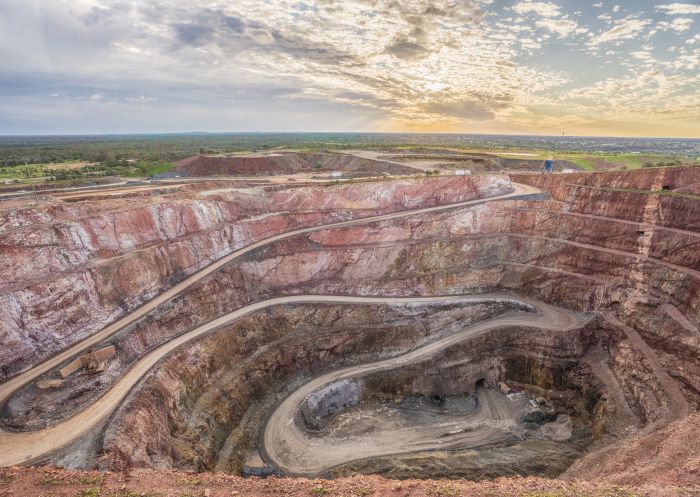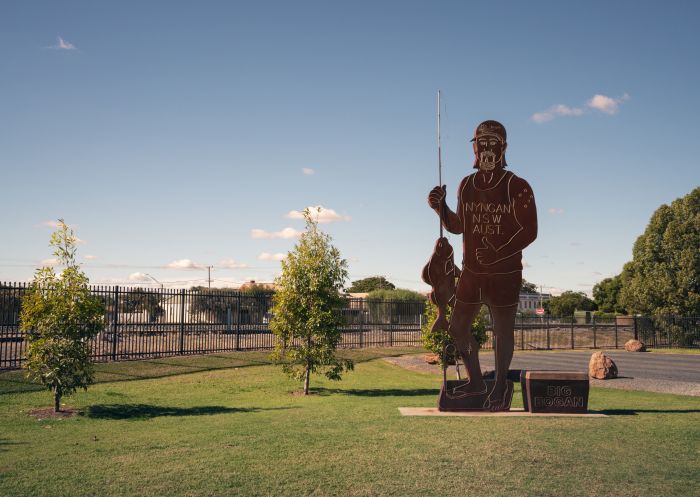

Cobar & surrounds
The Cobar sign in the historic mining town in Outback NSW



The Cobar area of central NSW is a fascinating union of country towns like Cobar and Nyngan, which were built off the back of copper and agricultural booms in the 1800s. Take a deep dive into this heritage as well as Aboriginal history, then meet the locals at a classic outback pub.
Cobar was put on the map (quite literally) in the 1870s, when copper was found in the area. Back then, the Great Cobar Copper Mine was Australia’s leading producer of copper. Today, remains of the smelter foundations are visible from the hill near the Great Cobar Museum.
Set inside the mine’s imposing administration building built in 1910, the Museum takes you on a journey through Cobar’s history from the time of the local Aboriginal people to the mining and agricultural era.
Just across the road is the Cobar Miners Heritage Park, an outdoor exhibit that takes you on a deeper dive into the town’s mining history. Across the lush grounds you’ll find a memorial to Cobar’s miners to honour those who lost their lives while at work.

'Rick the Miner' bronze sculpture, Cobar Mining Heritage Park
Follow the self-guided Cobar Heritage Walk to see the town’s historic buildings, including several from the Victorian and Edwardian eras, as well as early miners’ cottages. Along the way, be sure to stop for a photo op at the Big Beer Can, located above the entrance to the Grand Hotel and standing at about five metres tall.

Cobar Railway Station, Cobar
Then stop by the heritage-listed Great Western Hotel, a classic rural Australian corner pub with wide, shady verandahs and iron lacework. Peruse the historic photos that line the pub’s exterior, then drop in for a cool beverage and a chat with locals.

The Great Western Hotel, Cobar
Just minutes southeast from town, take a sealed road up to Fort Bourke Hill Lookout to view the Open Cut Mine, the township of Cobar and its surroundings. Or head the opposite direction to explore Cobar Sound Chapel, a permanent sound installation set in an old disused water tank.
Meanwhile, at Mount Grenfell Historic Site, 70km from Cobar, you can visit an important art site created by the Ngiyampaa people thousands of years ago. You can access the site via a short walk; when you reach the rocky overhang, marvel at richly coloured paintings of human and animal figures, representations of the natural environment, and hand stencils that are of ceremonial significance to traditional owners.

Cobar Open Cut Mine, Cobar
On the banks of the Bogan River, the beautiful rural town of Nyngan lies between the Outback and the green pastoral region to the east. Built on agriculture and the goldrush of the 1800s, Nyngan is a stop on the Cobb & Co Heritage Trail, which connects Bathurst and Bourke, following the routes the historic stagecoaches took transporting mail and passengers between remote outback towns.

Bogan River, Nyngan
If you’re following the route, be sure to pause at historic sites including the Nyngan Coach Works, the Heritage Coffee Shop (which has items from the coaching days), the post office, the Royal Hotel (on the riverbank, at the corner of Cobar and Nyngan Sts), Barrett's Hotel (in Nymagee St) and the Nyngan Museum, where you can see an exhibit tracing the 1835 journey of explorer Major Thomas Mitchell.

Nyngan Museum, Nyngan
Built by a group of retired shearers, the Mid-State Shearing Shed honours the local shearing industry, which has been a major player in the settlement of central NSW. Housed in a former railway shed, the gallery showcases shearing memorabilia, equipment and stalls, bag stencils and murals by local artists.

Mid State Shearing Shed Museum, Nyngan - Credit: Tayla Martin Photography
North of Nyngan, Macquarie Marshes Nature Reserve is one of the largest inland semi-permanent wetlands in southeast Australia and a major breeding area for waterbirds. It includes immense areas of Phragmites reeds, river red gum woodlands and mixed marsh floodplains, and was listed as a Ramsar wetland of international importance in 1986. Access is restricted, but at certain times of the year National Parks and Wildlife Service runs guided tours.

Macquarie Marshes Nature Reserve, Warrumbungle - Credit: John Spencer
If you are looking to tick off another one of Australia's quirky 'Big Things', the five-metre-tall Big Bogan stands proud in the centre of town with his mullet, stubbies, Southern Cross tattoo, fishing rod and esky. It’s a tongue-in-cheek nod to the fact that the town sits on the edge of the Bogan River, and also comes with plenty of local characters.

The Big Bogan, Nyngan
It’s an eight-hour drive to the Cobar area from Sydney, and around nine hours from Melbourne. Alternatively, you can fly to Dubbo, which is a three-hour drive from Cobar and two hours from Nyngan. 4WD vehicles are recommended for unsealed roads and many of the national parks. There are a number of places to stay in the Cobar area, from motels to caravan parks.

Callubri Station, Buddabadah - Credit: Jeff Chen
Stay connected to Visit NSW for all the latest news, stories, upcoming events and travel inspiration.
All the insider news, tips and inspiration you need to plan your next trip, delivered straight to your inbox.
Sign UpVisitNSW.com is the official tourism site for Destination NSW.
© Copyright 2025 Destination NSW. All rights reserved